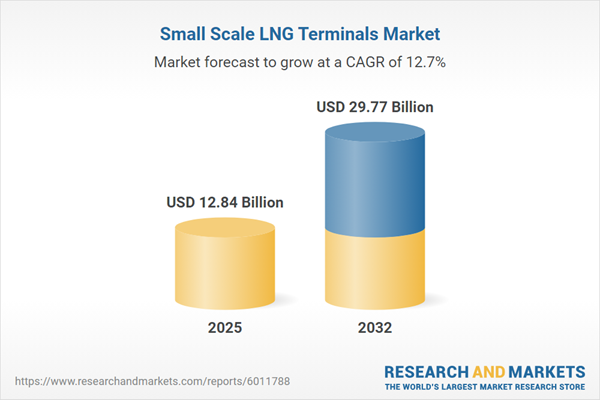Speak directly to the analyst to clarify any post sales queries you may have.
Small scale LNG terminals play a critical role in meeting global energy transition goals by providing flexible, decentralized infrastructure for efficient liquefied natural gas handling and distribution. Their agility in deployment and adaptability to various regional needs position them as strategic assets for stakeholders seeking operational resilience and growth opportunities in the evolving energy landscape.
Market Snapshot: Small Scale LNG Terminals Market
The Small Scale LNG Terminals Market advanced from USD 11.46 billion in 2024 to USD 12.84 billion in 2025. Projected to maintain a compound annual growth rate (CAGR) of 12.66%, the market is expected to reach USD 29.77 billion by 2032. Robust growth is fueled by decarbonization initiatives, a rising need for flexible energy infrastructure, and the increasing significance of distributed energy solutions. Modular designs and evolving regulatory standards further sustain expansion while ensuring compliance and operational performance.
Scope & Segmentation of the Small Scale LNG Terminals Market
The research spans comprehensive segmentation and technology coverage, equipping leaders with actionable insights.
- Terminal Types: Liquefaction terminals; Regasification terminals.
- Modes of Supply: Rail; Transshipment and bunkering solutions; Truck-based distribution.
- Applications: Heavy-duty vehicles; Industrial feedstock needs; Marine transport; Power generation; Residential and commercial building supply.
- Regional Markets: Americas (United States, Canada, Mexico, Brazil, Argentina, Chile, Colombia, Peru); Europe, Middle East & Africa (United Kingdom, Germany, France, Russia, Italy, Spain, Netherlands, Sweden, Poland, Switzerland, United Arab Emirates, Saudi Arabia, Qatar, Turkey, Israel, South Africa, Nigeria, Egypt, Kenya); Asia-Pacific (China, India, Japan, Australia, South Korea, Indonesia, Thailand, Malaysia, Singapore, Taiwan).
- Leading Companies: Aker Solutions ASA; Anthony Veder Group N.V.; Baker Hughes Company; Black & Veatch Corporation; Chart Industries, Inc.; Cryostar SAS; ENGIE SA; Excelerate Energy, Inc.; Gasum Ltd.; Gaztransport & Technigaz S.A.; Honeywell International Inc.; IHI Corporation; JGC Holdings Corporation; Kanadevia Corporation; Kawasaki Heavy Industries, Ltd.; Linde PLC; McDermott International, Inc.; Mitsubishi Heavy Industries, Ltd.; Petronet LNG Limited; PGNiG SA; Saipem S.p.A.; Samsung E&A Co., Ltd.; Shell International B.V.; Snam S.p.A.; SOFREGAZ- SAS; TotalEnergies SE; Wärtsilä Corporation.
Key Takeaways for Senior Decision-Makers
- Decentralized small scale LNG terminals offer operational flexibility for remote sites, marine bunkering, and industrial applications, adapting quickly to varied demand.
- Integrating digital monitoring and predictive analytics enables operators to optimize asset performance and comply with evolving environmental and safety standards.
- Strategic partnerships across regions and supply chains drive innovation in modular design, decrease construction timelines, and lower capital barriers for new market entrants.
- Tariff realignments, especially from the United States, are actively reshaping procurement practices and promoting local fabrication and technology transfer agreements.
- Sector coupling with hydrogen blending and renewable-driven processes enhances the terminals’ role in supporting energy transition and grid resilience initiatives.
Tariff Impact and Competitive Realignment
Recent revisions in United States tariffs on LNG equipment and specialized components have prompted companies to reassess sourcing, supply routes, and investment timelines. Many developers are favoring domestic procurement and long-term agreements to offset added duties. While causing short-term cost pressures, these adjustments are expected to foster design optimization and spur innovations in materials and logistics efficiency.
Methodology & Data Sources
This report combines insights from primary interviews with terminal operators, manufacturers, and logistics experts, along with thorough review of industry publications, regulatory filings, and technical documentation. Scenario mapping and GIS overlays were used to evaluate site suitability and market trajectories under different regulatory and technology adoption scenarios, ensuring a reliable and actionable foundation.
Why This Report Matters
- Enables informed capital allocation by clarifying regional and application-specific opportunities in the small scale LNG terminals market.
- Equips leaders to anticipate regulatory, technological, and supply chain developments so they can proactively mitigate risks and accelerate deployment.
- Offers a benchmarking resource covering leading global players, giving decision-makers insights on best practices, innovation strategies, and partnership models.
Conclusion
The evolution of small scale LNG terminals presents new possibilities for flexible, sustainable energy distribution. Senior leaders able to align strategies with shifting dynamics in technology, regulation, and trade will be best placed to capture emerging growth and ensure long-term resilience.
Additional Product Information:
- Purchase of this report includes 1 year online access with quarterly updates.
- This report can be updated on request. Please contact our Customer Experience team using the Ask a Question widget on our website.
Table of Contents
3. Executive Summary
4. Market Overview
7. Cumulative Impact of Artificial Intelligence 2025
Companies Mentioned
The companies profiled in this Small Scale LNG Terminals market report include:- Aker Solutions ASA
- Anthony Veder Group N.V.
- Baker Hughes Company
- Black & Veatch Corporation
- Chart Industries, Inc.
- Cryostar SAS
- ENGIE SA
- Excelerate Energy, Inc.
- Gasum Ltd.
- Gaztransport & Technigaz S.A.
- Honeywell International Inc.
- IHI Corporation
- JGC Holdings Corporation
- Kanadevia Corporation
- Kawasaki Heavy Industries, Ltd.
- Linde PLC
- McDermott International, Inc.
- Mitsubishi Heavy Industries, Ltd.
- Petronet LNG Limited
- PGNiG SA
- Saipem S.p.A.
- Samsung E&A Co., Ltd.
- Shell International B.V.
- Snam S.p.A.
- SOFREGAZ- SAS
- TotalEnergies SE
- Wärtsilä Corporation
Table Information
| Report Attribute | Details |
|---|---|
| No. of Pages | 187 |
| Published | November 2025 |
| Forecast Period | 2025 - 2032 |
| Estimated Market Value ( USD | $ 12.84 Billion |
| Forecasted Market Value ( USD | $ 29.77 Billion |
| Compound Annual Growth Rate | 12.6% |
| Regions Covered | Global |
| No. of Companies Mentioned | 28 |









